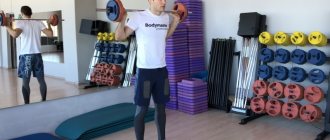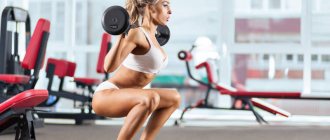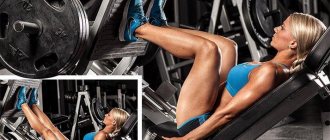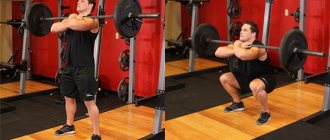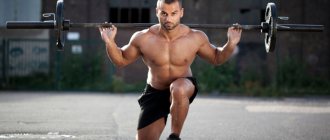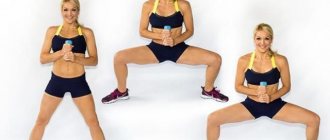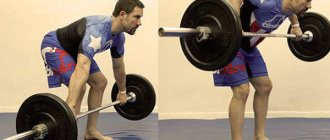Jump squats are a rather interesting exercise in terms of load, which are deservedly popular among CrossFit and fitness enthusiasts. On the one hand, in it we work out the quadriceps perfectly, working in full amplitude and in an explosive manner, on the other hand, we additionally train our heart, since this exercise also contains aerobic exercise.
Few exercises that do not require the use of additional weights can increase the pace of your workout as much as jump squats. The only things that come to mind are various variations of burpees (with jumping onto a box, jumping over a barbell, pulling up on a horizontal bar, etc.). The work is really colossal: due to the fact that we work non-stop, without giving our muscles a rest, the body does not have time to restore ATP reserves, glycogen reserves in our muscles are quickly consumed, the maximum number of muscle fibers, both fast and slow, and the heart rate can easily reach 140-160 beats per minute, so people suffering from arterial hypertension or other problems with the cardiovascular system should perform this exercise with great caution - such an intense load may be for them excessive and dangerous.
In our article today we will look at the following features of this exercise:
- What are the benefits of jump squats?
- Technique for performing the exercise;
- CrossFit complexes containing this exercise.
What do jumping give?
In strength sports, the development of the fastest possible muscle contraction is used in squats, deadlifts, as well as clean and jerks. Therefore, jump squats are a combination of two exercises that increase each other’s effectiveness and contribute to progression in weightlifting and powerlifting. The main goal of the exercise is to give a more powerful impulse at the bottom or “dead” point of the movement, which allows you to perform the element with high quality while observing the technique.
In fitness, jumping is used in two main variations.
- When working with heavy weights to improve working weights in squats.
- Also, half squat jumps (with knees at a right angle or higher) without weight are one of the most popular movements for HIIT and bodyweight supersets.
What muscles work
When jumping from a low seat, the main load falls on:
- Quadriceps.
- Gluteus major.
- Adductor muscles of the thigh.
- Calf muscles.
The core and back muscles also work in static mode.
Execution technique
Jumping out of a full squat is a complex exercise that requires full adherence to technique. This is especially true for the landing phase, which is considered the most traumatic if performed incorrectly.
Jumping technique:
- Take a jumping position, the starting point is in a sitting position. Try to squat as low as possible while keeping your back straight (hips below parallel to the floor).
- Keep your hands near your chest in a free position, the body is tilted forward so that the pelvis does not tuck inward and is pulled back.
- Make a powerful push from your heels, stand up and, using the given inertia, make a jump to the maximum height.
- During the jump, the arms are straightened at the elbow and moved back slightly to maintain balance in the air.
- Land softly on your toes, squat below the parallel of your thighs with the floor and jump again from a low position.
It is extremely important to do the jumps on a soft surface. This applies to both beginners and professionals, who can easily jump onto a stand as tall as they are. The soft surface does not return momentum upon landing and “quenches” inertia, which allows you to maintain healthy joints and spine. Therefore, try to do squat jumps on the ground, mats or any other non-hard surface.
The importance of training muscle strength in jumping disciplines[edit | edit code]
Typical phase structure of a jump:
- the preparation phase for developing a high take-off speed or starting from an optimal starting position;
- the main phase with vigorous straightening of the leg during the push and then movements in flight;
- the final phase with a safe landing at the optimal flight path.
The goal of all types of athletics jumps is to develop horizontal speed during the run-up and direct the body with a vertical push into a flight path corresponding to the specifics of the sports discipline. This trajectory must then be used optimally so that in the final phase the landing provides maximum results. When pole vaulting, this sequence is complicated by the fact that the physical laws of the lever and pendulum apply when the pole moves.
The central element of all types of jumps, which is crucial for the result, is the run-up and take-off complex. Achieving the maximum height or length of the jump depends on it.
The main phase of the jump with leg straightening during the push is a basic movement that plays a major role in performing a movement that requires a large or maximum possible application of force. In this case, jumping strength as a component of fast strength is crucial. As the speed increases and during a fast take-off, the reactive force dominates, which, again, refers to the fast force[1].
Since maximum strength, which is the basis of all types of physical strength, depends in part on the cross-sectional area of the muscles, increasing the cross-sectional area in jumping disciplines also has a direct positive effect on performance and is therefore the goal of strength training.
Jumping options with weights
In fact, you can do jumping jumps while crouching in a deep position with any type of weights. However, dumbbells, barbell plates and kettlebells are considered the most convenient. Also in some gyms they practice jumping out of a squat together with a barbell, although due to the length of the bar this option is considered not the most convenient (available only in spacious halls where there is enough space to perform the element).
The basic technique of movement does not change depending on the projectile used. The main differences relate to the way the arms work and the upper body supports the weight. Also, significantly more stress is placed on the arms, shoulders and back when working with weights.
Jumping technique with dumbbells
Dumbbells are the easiest option.
- At the starting point, the arms are slightly bent and located near the hips.
- During the jump, the arms are straightened, the weight is kept on the relaxed limbs.
Jumping with a weight plate
Barbell plate – the most convenient option is to press the plate to your chest. Hug it with your arms crosswise, this will help securely fix the projectile and not distort the technique.
Barbell Squat Jumps
Barbell – Secure a barbell across the back of your shoulders, just like you would for a squat. Frontal holding of the bar is also allowed, but in this case a greater load will be placed on the abdominal muscles, which can “lead” the athlete forward and lead to loss of balance.
Jumping with a sandbag
Sandbag – Hold the bag in a bear hug in front of you, or place it on the back of your shoulders, just below your neck. The bag is more convenient because, unlike a barbell, it is streamlined and more compact. Allows you to work with heavy weights. More about sandbags →
also important to remember that squat jumps should not be done with heavy weight. With this technique, the body gains less inertia and the joints are loaded much more heavily. Also, this technique does not lead to a pronounced development of explosive power in the quadriceps to the same extent as jumping out of a deep squat.
Conventionally, exercises for developing jumping ability can be divided into two areas:
1. Increasing the output force (the force with which you push off the ground). 2. Increasing the rate of force generation, that is, at what speed the force is created and applied.
It is the combination of these two aspects that allows a person to push his body off the ground. These two variables are the answer to questions for those athletes who have tried in vain for years to jump higher or further. Since our answer has two parts, let's talk about them separately and then put them together again.
Increased force output
Sounds simple. This means that you need to become stronger. But the process of building strength is a separate topic that can be quite complex and extensive. Therefore, we will consider simple but effective methods. Given our goal (increasing jump), we will focus on strengthening the lower body muscles.
The signature exercise for developing jumping strength is the squat with weights. Especially deep squats. It is by squatting below parallel with a heavy weight that you strengthen the muscles necessary for a vertical jump.
In 2012, the Journal of Strength and Conditioning Research published a study in which 59 participants were divided into 3 groups and performed three variations of squats: deep front squats, back squats, and partial range squats. Before starting the study, each participant completed a series of tests, including a maximum vertical jump test, as well as a measurement of the rate of force generation. Subjects who performed front squats and squats with a barbell on their shoulders, after a certain period of training, improved their results by 2 cm. Those who performed squats with a partial amplitude showed no changes in their jump.
In addition to the above, each test group also completed a control 1RM of each squat. The results showed that the deep squat athletes increased their weights in all three squats, while the partial squat subjects improved only on this exercise. Also, in the group that performed deep squats, the rate of force generation did not change, but in the athletes who squatted to half the amplitude, the results fell.
Thanks to this research we can highlight the following:
1. Deep squats increase jump height. 2. Deep squats increase the amount of force generated, despite the amplitude. 3. Partial squats reduce the rate of force generation.
So now we know how to develop the first variable, namely the output force. A study has shown that deep squats will help us jump higher.
Let's talk about the speed of force generation. Now we understand that in order to increase the jump by more than a couple of centimeters, we still need to work on the rate of force generation, and thus the power of the simultaneously generated force will increase sharply. You may have a question: how to replace squats with a barbell without losing the effectiveness of the exercise. It's simple, use sandbag. This equipment is easy to use, compact and does not require a trip to the gym. You can perform special exercises with it to develop jumping ability, without resorting to iron.
FORCE GENERATION RATE
Squats alone will not help increase the rate at which force is generated. The deep squat mainly affects the muscles, but to increase the reaction speed of the muscles, we need to train the nervous system. This means that we must concentrate on using more threshold units. These motor units are activated when you increase the load and try to lift it as quickly as possible.
Weightlifting exercises are great for developing these threshold units. But the technique of performing a snatch or clean is difficult to perform and takes a lot of time to master. In addition, since the technique of these exercises is not simple, its absence can slow down progress. But if you don’t plan to become a weightlifter, you can confidently replace the barbell with a sandbag and perform bag cleans on your chest or shoulder. This exercise uses the same motor units and teaches you to “join” the movement powerfully and simultaneously.
LET'S SUMMARY
So, we found a great combination of movements: the best for developing force output (deep squats with sandbags) and the best for increasing the rate of force generation (shoulder sandbags). To combine these exercises, we use linear periodization, which was also used in the deep squat study.
These exercises can be performed twice a week; if done more often, recovery problems may occur, which may affect progress. They can also be performed in conjunction with any training program. You just need to take into account that they also require energy expenditure and their implementation can affect the training process.
So, here is a set of exercises for jumping and coordination:
Hypertrophy phase:
— Taking a sandbag on the shoulder 4 x 5, alternating the shoulder from approach to approach — Deep squats with a sandbag on the back 4 x 10 — Rest: 1.5 minutes, 1.5 minutes between sets. Perform 4 sets of cleans first, then move on to squats. Increase the working weights in exercises by 1-3 kg every week. — Phase duration: 4 weeks
Maximum strength building phase:
— Taking a sandbag on the shoulder 4 x 4 — Deep squats with a sandbag on the back 5 x 5 — Rest: 2.5 min. We act according to the algorithm of the past mesocycle. As you get fewer reps per set, update your weights. — Phase duration: 6 weeks
Speed-strength phase:
— Taking a sandbag on the shoulder 4 x 3
— Rest: 3 min. We act according to the algorithm of the past mesocycle. Go to near-maximum weights on both exercises. — Phase duration: 4 weeks
Build-up phase:
During this phase, perform alternate sets.
— Taking a sandbag on the shoulder 5 x 3 — Deep squats with a sandbag on the back 5 x 3 — Rest: 3 min. — Phase duration: 3 weeks
Almost all athletes try to improve their vertical jump. This exercise allows you to work all the muscles of your legs, making them powerful, strong and resilient. In some sports, having a good vertical jump is simply necessary, these include, for example, basketball, volleyball, football, athletics and many others.
There are several techniques that can help you learn and improve your vertical jump. It is not necessary to choose any particular program; most experts recommend taking several exercises from each training plan and thus creating your own individual sessions.
Each of the techniques can be aimed at strength, dynamics or power. The ideal option would be a combination of both. It is also worth remembering that each body is individual and can react differently to different exercises. There is no need to blindly believe those who promise to improve your vertical jump with a 100% guarantee and offer the ideal method for improving it. This simply cannot happen, since there are only fundamentals that are worth sticking to, but there is no magic, fully equipped program. This is all covered in great detail in the book: « »
, where everything is discussed consistently and clearly.
To make it more clear, we can divide all exercises to increase vertical jump into three main groups of strength training. For beginners, the first option is more suitable. If you have already dealt with weights, then you can pay attention to the second program and add a little dynamics to the training process. More advanced athletes are definitely recommended to include plyometric exercises in their training. The ideal option, of course, would be a combination of all techniques to achieve the best result.
Why should the emphasis be placed on strength? The foundation of the vertical jump is power, which in turn is built from strength and speed. By developing strength qualities, the athlete thereby strengthens the muscles that create the pushing effect. To make a high jump, you need to work the muscles of the whole body.
An experienced athlete, increasing only strength, may lose speed over time, and this in turn will affect power. Therefore, you should definitely supplement your training with dynamics. However, for the beginner, the following strength training option is a great place to start on your way to the top of your vertical jump. At the initial stage, it is better to do all exercises under the supervision of a qualified trainer.
The program is designed to progress over 7 weeks. It is best to exercise 2 or 3 times a week. These vertical jump exercises must be performed with the maximum weight with which you can do the required number of approaches and repetitions.
Table No. 1. Power training
| № | Exercise | Performance |
| 1 | Squat | We do a squat: the knees do not go beyond the tips of the fingers, we keep our back straight, the emphasis is on the legs and not on the lower back, the buttocks do not fall below the level of the knees. We return to the starting position. The exercise can be performed with either a barbell or dumbbells. |
| 2 | Chest press | Lying with your back on the bench, we begin to lift the barbell with the maximum possible weight above our head, then return to the starting position. Since the goal is to work the muscles of the torso and arms, you should not bend your back as in powerlifting and try to “bridge” |
| 3 | Lunges with dumbbells | We lunge forward with our right leg and, leaning on it, squat. We return to the starting position. Repeat with the other leg |
| 4 | Bar pull | You will need a simulator with a movable bar. We sit down and begin to pull the bar down, then returning our hands to their original position. If it is not possible to exercise on a simulator, you can use a regular horizontal bar and do pull-ups on it |
| 5 | Calf raise | We stand on our toes on a small hill, heels in the air, dumbbells in our hands. We begin to rise up on our toes, feeling the stretch in the calf muscle. The push should be sharp and powerful. Then we return to the starting position |
| 6 | Standing Dumbbell Press | We bend our arms with dumbbells at the elbows at shoulder level. Raise dumbbells above your head and lower them back |
| 7 | Crunch | Lying on the floor on your back, knees bent, hands on the back of your head. We begin to lift the body up, lifting off the floor only with the shoulder blades, the abs should be tense, the lower back should lie on the mat. We return to the starting position. To add weight during the exercise, you can hold dumbbells on your chest |
All exercises are performed with weights that may be slightly less than the athlete’s body weight.
It's best to start with 5 or 6 repetitions in 2 sets. Over time, the body will begin to get used to it, then you can increase the number of approaches and try to take the maximum possible weight for yourself. Since the work in this program is aimed specifically at increasing strength, it is worth focusing on the limits of muscle capabilities, trying to get out of the comfort zone and move further in performance. Download the table of strength exercises in pdf format:
Dynamic strength training
Since the vertical jump is affected not only by strength, but also by speed, it is also worth paying special attention to. In these exercises, the main emphasis is on developing explosive movements, using the full potential of muscle amplitude. Weight should not have a detrimental effect on the exercise, because then the speed will suffer and the whole point of the workout will be lost.
This program is designed for more experienced athletes who can withstand maximum loads. Since the technique is complex in most cases, it is recommended that if you have no experience, you initially work with a trainer who can advise and correct if necessary. There are few exercises, but they are effective. This means combining them with some elements from the previous program at your discretion.
Table No. 2. Dynamic strength training
| № | Exercise | Performance |
| 1 | Barbell Squat | We start squatting and then jump up, trying to do it as high as possible. Keeping the pace, we immediately lower ourselves into a squat and then jump again |
| 2 | Barbell Chest Raise | From a semi-squat position, with the barbell in front of you on the floor, we begin to straighten up, lifting the barbell and throwing it over onto our chest, then return to the starting position. |
| 3 | Throwing the bar up | Lying on a bench, the barbell in front of you with your arms outstretched. We bend our elbows a little, lowering the barbell down, and then with a sharp movement we throw it up. We repeat the exercise without stopping. |
These dynamic vertical jump exercises can be performed according to the scheme of 10 repetitions in 3 sets, gradually increasing the load weekly.
At this rate, by week 7-8 you can achieve a result of 4 sets of 20 repetitions. Initially, of course, difficulties may arise, since the exercises are not easy, and to perform them you must already have developed basic muscle mass. However, if you exercise regularly and are not lazy, then in two months you will be able to see how powerfully your strength and speed qualities have improved. Download the table of dynamic strength training in pdf format:
Plyometric training
Plyometrics as a training technique is considered one of the most effective because it uses both strength and speed. All this together gives explosive power, making the vertical jump higher. Plyometric training works not only the lower body, but also the upper body, giving a comprehensive workout to all muscles.
This program can be perfectly combined with traditional strength training. Together they will give an excellent result, which will be visible in the near future. Plyometrics combines exercises of varying degrees of intensity, which allows even beginners to start working with it. Below is a list of exercises that involve both the upper and lower parts - this training session is considered the most optimal. More detailed plyometric training programs of varying degrees of intensity can be found in the book: « »
Table No. 3. Plyometric training
| № | Exercise | Performance |
| 1 | Jumping out | From a half-squat position, we begin to jump up. To increase the sharpness of the movement, you can also throw your arms above your head |
| 2 | Push-up | The exercise is similar to regular push-ups, but it is complicated by the fact that while pushing off the ground you need to clap your hands. This will give dynamics |
| 3 | Jumping | We jump onto a small hill with both feet and help with our hands, making amplitude movements. We return to the starting position calmly |
| 4 | Throws | From a standing position, with your feet shoulder-width apart, throw the ball forward from behind your head with a sharp movement. Only the arms work, the lower back does not bend. |
| 5 | Bounce | Feet shoulder-width apart, knees bent. We jump up, tucking our knees to our chest. It is important not to reach your chest towards your knees, but vice versa. We help ourselves in the jump with our hands |
| 6 | Throwing away | From a squat we stand up and throw the ball back behind our head with a sharp movement. Then we return to the starting position. It's better to have several balls on hand at once so as not to lose momentum |
All exercises should be performed at a pace, without making long stops between repetitions and approaches. The increasing load schedule for each exercise should start with 7 repetitions of 2 sets, gradually reaching the 7th week with a result of approximately 3 sets of 20 times. These parameters are indicative for monitoring your own performance. Don't forget that the best training for improving your vertical jump is pushing yourself to the limit. You can always achieve great results, so everything depends only on your own desires and the right motivation.
Download the plyometric training table in pdf format:
Conclusion
When thinking about how to increase your vertical jump, you should be more careful in choosing a training program and not settle on just one. All the proposed methods are good if used together, changing exercises and selecting the most suitable one for the individual characteristics of the body and physical capabilities.
This is a classic plyometric exercise that involves a powerful upward jump from a squat. A so-called explosive load is created, that is, a quick effort is made in a short period of time, which develops muscle strength and increases their volume.
Jumping can be done with a minimum level of training, but do not forget to strictly control the technique and monitor your own sensations. In most cases, additional equipment for the exercise will not be required, unless you use weights.
Training Recommendations
- Never start lifting weights. First, you need to completely master and learn the entire sequence of actions when performing jumping, and then move on to working with minimal weights. This way your ligaments, muscles and joints will be ready for gradually increasing loads.
- To perform jumps without consequences, the lower leg muscles must be sufficiently developed. A soft landing on your toes depends on them. Never rest on your heels or your entire foot.
- Do not perform low squat jumps with squats. To increase efficiency, it is better to divide these exercises into different training sessions.
- To train for maximum explosion, do not do long series of jumps. The greatest effectiveness is shown by single jumps with a rest of 10-15 seconds. When working without weights, the exercise can be done in series of 5-10 repetitions.
- Before starting a workout, always do a complete warm-up of your entire body, from neck to heels. Despite the fact that the main load falls on the lower body, insufficiently warmed back muscles can lead to increased compressive load on the spine.
What are the benefits of jumping over a barbell?
1. General development of all leg muscles 2. Development of endurance of muscles and the body as a whole 3. Since jumping over a barbell is a cardio exercise, the load is aimed at developing the heart muscle 4. Improving physical performance: explosive strength of the legs and dexterity of the body. 5. Improving the functioning of the vestibular apparatus and movement coordination.
As you can see, for CrossFit the list of “advantages” of jumping over the barbell is quite large. Without developing all the above data, it is useless to talk about any results in sports.

